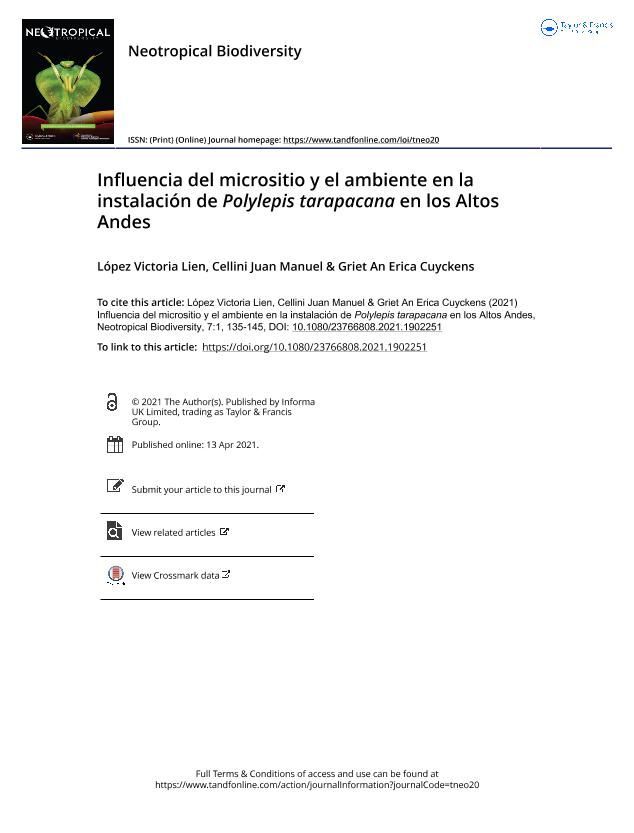Artículo
Del total de micrositios presentes en un ambiente, solo una fracción presenta condiciones adecuadas para asegurar la regeneración del bosque. Este estudio analiza la facilitación dada por el ambiente y los micrositios a la regeneración de P. tarapacana en los Altos Andes. Se trabajó con 21 bosques en Jujuy, Argentina, registrándose variables de estructura forestal, humedad de suelo y la oferta de micrositios para la instalación de renovales. Se realizó un análisis de correlación de Pearson entre variables ambientales y de estructura forestal de renovales y de árboles y arbustos. Además, se realizó un ANOVA simple utilizando 8 categorías de micrositios como factor principal para analizar la humedad del suelo y la densidad de renovales. La densidad de renovales representa el 36.8% de la densidad de árboles y arbustos. A mayores pendientes la presencia de renovales disminuye, pero no se hallaron diferencias significativas con la altitud. Se encontró una mayor densidad de plántulas (201.2 y 279.5 ind.ha−1) en micrositios bajo la influencia de rocas que coindicen con una mayor humedad de suelo, pero no así en micrositios con hojarasca, con un mismo contenido de humedad. Existió una oferta variada de micrositios posibles de encontrar en la zona de estudio, donde la densidad de los renovales se relacionó positivamente con la oferta de micrositios bajo la influencia de rocas, y estuvo asociada a la humedad relativa de los mismos. Estos resultados permiten definir los micrositios propicios para la regeneración de P. tarapacana pudiendo ser utilizados para identificar las áreas más adecuadas para la restauración y conservación de esta especie. Of the total numbers of microsites present in an environment, only a fraction presents adequate conditions to ensure the regeneration of the forest. This study analyzes the facilitation given by the environment and the microsites in the P. tarapacana regeneration in the High Andes. We worked with 21 forests in Jujuy, Argentina, registering variables of forest structure, soil moisture and the offer of microsites. Pearson correlation analyses were done between environmental variables and forest structure of seedling and trees and shrubs. In addition, a simple ANOVA were performed using 8 categories of microsites as the main factor to analyze soil moisture and the density of seedling. The density of seedling represents 36.8% of the density of trees and shrubs. At greater slopes, the presence of seedling decreases, but no significant differences were found with altitude. A higher seedling density (201.2 and 279.5 ind.ha−1) was found in microsites under the influence of rocks that coincide with higher soil moisture, but not in microsites with litter, with the same moisture content. There was a varied offer of microsites that could be found in the study area, where the density of the seedling was positively related to the offer of microsites under the influence of rocks and was associated with their relative humidity. These results define microsites favorable for regenerating P. tarapacana which can be used to identify the most suitable areas for restoration and preservation of this species.
Influencia del micrositio y el ambiente en la instalación de Polylepis tarapacana en los Altos Andes
Fecha de publicación:
04/2021
Editorial:
Taylor & Francis Ltd
Revista:
Neotropical Biodiversity
ISSN:
2376-6808
Idioma:
Inglés
Tipo de recurso:
Artículo publicado
Clasificación temática:
Resumen
Palabras clave:
QUEÑOA DE ALTURA
,
SAFE SITE
,
SAPLINGS
,
SEEDLING
,
SOIL MOISTURE
,
TOPOGRAPHY
Archivos asociados
Licencia
Identificadores
Colecciones
Articulos(CCT - LA PLATA)
Articulos de CTRO.CIENTIFICO TECNOL.CONICET - LA PLATA
Articulos de CTRO.CIENTIFICO TECNOL.CONICET - LA PLATA
Articulos(INECOA)
Articulos de INSTITUTO DE ECORREGIONES ANDINAS
Articulos de INSTITUTO DE ECORREGIONES ANDINAS
Citación
Lopez, Victoria Lien; Cellini, Juan Manuel; Cuyckens, Griet An Erica; Influencia del micrositio y el ambiente en la instalación de Polylepis tarapacana en los Altos Andes; Taylor & Francis Ltd; Neotropical Biodiversity; 7; 1; 4-2021; 135-145
Compartir
Altmétricas




